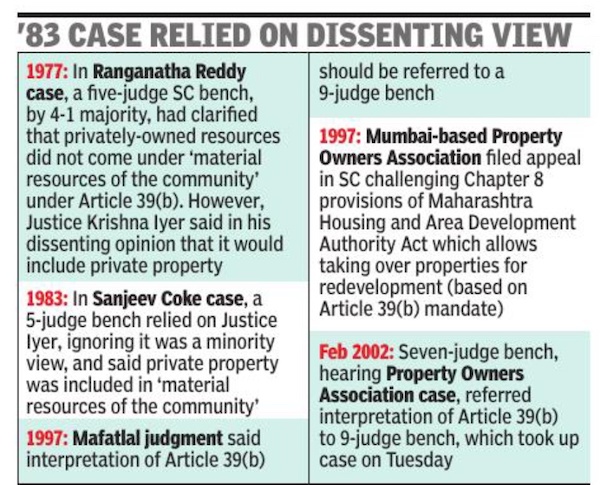Article 39(b) of the Constitution of India
(Created page with "{| class="wikitable" |- |colspan="0"|<div style="font-size:100%"> This is a collection of articles archived for the excellence of their content.<br/> Additional information ma...") |
|||
| Line 7: | Line 7: | ||
|} | |} | ||
| − | [[Category:India | | + | [[Category:India |C ]] |
| − | [[Category:Law,Constitution,Judiciary | | + | [[Category:Law,Constitution,Judiciary |C ]] |
=Redistribution of private properties for greater common good= | =Redistribution of private properties for greater common good= | ||
| Line 14: | Line 14: | ||
[https://epaper.indiatimes.com/article-share?article=24_04_2024_001_017_cap_TOI Dhananjay Mahapatra, April 24, 2024: ''The Times of India''] | [https://epaper.indiatimes.com/article-share?article=24_04_2024_001_017_cap_TOI Dhananjay Mahapatra, April 24, 2024: ''The Times of India''] | ||
| − | [[File: Article 39(b) of the Constitution of India | + | [[File: Article 39(b) of the Constitution of India- SC Judgements, 1977-2002.jpg| Article 39(b) of the Constitution of India: SC Judgements, 1977-2002 <br/> From: [https://epaper.indiatimes.com/article-share?article=24_04_2024_001_017_cap_TOI Dhananjay Mahapatra, April 24, 2024: ''The Times of India'']|frame|500px]] |
New Delhi : A nine-judge bench of the Supreme Court commenced the process for interpretation of Article 39(b) of the Constitution to determine whether this directive principle of state policy provision allows govt to treat and redistribute privately owned properties under the garb of “material resources of the community” for greater common good. | New Delhi : A nine-judge bench of the Supreme Court commenced the process for interpretation of Article 39(b) of the Constitution to determine whether this directive principle of state policy provision allows govt to treat and redistribute privately owned properties under the garb of “material resources of the community” for greater common good. | ||
Latest revision as of 17:25, 4 May 2024
This is a collection of articles archived for the excellence of their content. |
[edit] Redistribution of private properties for greater common good
[edit] 2024 Apr: SC to deliberate
Dhananjay Mahapatra, April 24, 2024: The Times of India

From: Dhananjay Mahapatra, April 24, 2024: The Times of India
New Delhi : A nine-judge bench of the Supreme Court commenced the process for interpretation of Article 39(b) of the Constitution to determine whether this directive principle of state policy provision allows govt to treat and redistribute privately owned properties under the garb of “material resources of the community” for greater common good.
The interpretation by a bench comprising Chief Justice D Y Chandrachud and Justices Hrishikesh Roy, B V Nagarathna, S Dhulia, J B Pardiwala, Manoj Misra, R Bindal, S C Sharma and A G Masih stems from Justice V R Krishna Iyer’s dissenting view in Ranganatha Reddy case of 1977 that community resources included private properties and the conflation of the two in later judgments, leading to the matter being referred on Feb 20, 2002, for interpretation by a nine-judge bench. Article 39(b) provides that the state shall direct its policy towards securing “that the ownership and control of the material resources of the community are so distributed as best to subserve the common good”.
Senior advocates Devraj, Zal Andhyarujina and Sameer Parikh argued that community resources could never include privately owned properties. Arguments will continue on Wednesday.
Why SC’s nine-judge bench needs to interpret Art 39(b)
The advocates termed Justice Iyer’s view a reflection of his Marxist socialist ideology which had no place in a democratic country governed by a Constitution giving primacy to fundamental rights of citizens.
Though the question is old, it is reverberating in current politically-surcharged atmosphere after Rahul Gandhi’s speech at a public meeting on Saturday where he said, “First, we will conduct a caste census... to know the exact population and status of backward castes, SCs, STs, minorities and other castes. After that, financial and institutional survey will begin. Subsequently, we will take up the historic assignment to distribute the wealth of India, jobs and other welfare schemes to these sections based on their population.”
PM Modi quickly reacted to this by alleging that Congress will take away private wealth of citizens for redistribution and juxtaposed it with the 2006 speech of exPM Manmohan Singh.
Solicitor general Tushar Mehta said the sole question before the court was interpretation of Article 39(b) and not Article 31C, the provision which provides safe harbour to laws enacted in pursuance of the directive principles, whose validity as it existed prior to the 25th constitutional amendment in 1971 has been upheld by a 13-judge bench in Kesavananda Bharti case.
CJI Chandrachud agreed and explained why Article 39(b) needed to be interpreted by a nine-judge bench. “The reason for the exercise before the nine-judge bench is that though majority in the Ranganatha Reddy case in 1977 clarified that material resources of the community do not include private property, a fivejudge bench in Sanjeev Coke in 1983 relied on Justice Iyer ignoring that it was a minority view,” he said.
“In the meantime, SC in Mafatlal Industries case in 1997 opined that Article 39(b) needed interpretation by a ninejudge bench,” the CJI said. In the Mafatlal case, SC had said it was difficult to accept the broad view that material resources of the community under Article 39(b) covered what is privately owned.
The bench asked how excess agricultural land was distributed among poor peasants in the 1960s. Devraj said no one questioned the state’s power to acquire land for public purposes after paying a fair compensation to the owner of the land. Land ceiling laws were passed by states to determine excess land accumulated by zamindars and such excess land was then redistributed, he said.
“But if govt wants to take away my property and distribute it to the poor, then I would be left with no money as my fees would be taken away and paid to poor people,” he said in a lighter vein.